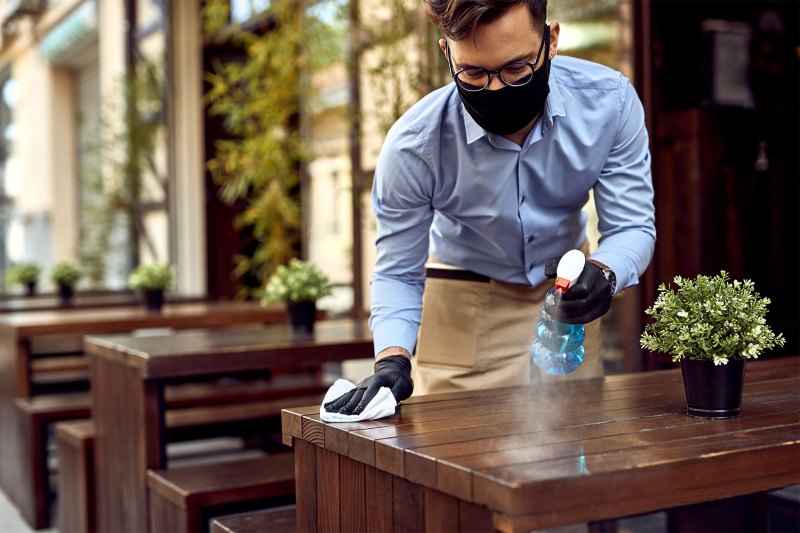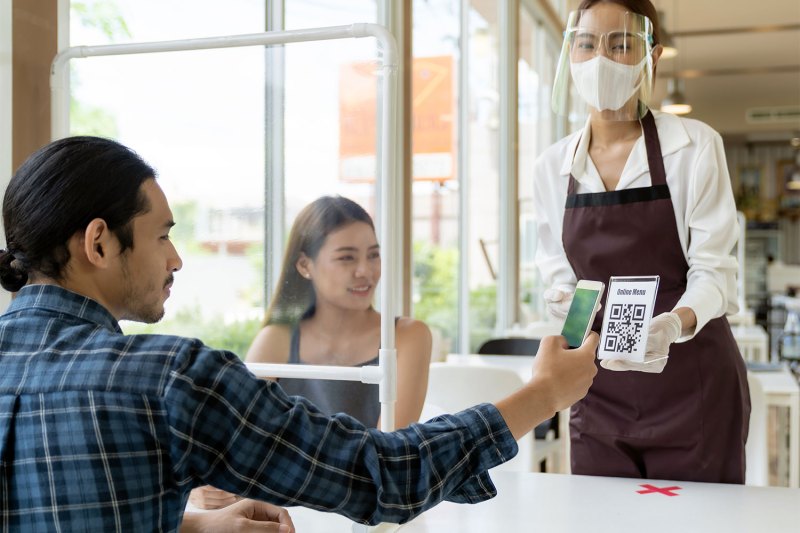As states move forward with their reopenings, restaurants are one of the types of businesses we’re most excited to start visiting again. Although take-out and delivery are all well and good, being shut inside our homes for months on end has reminded us of the joys and pleasures of dining out. And to comply with health and safety regulations, most restaurants are going above and beyond to keep their customers and employees safe, implementing socially distanced seating, creating outdoor dining areas, requiring the use of masks and face shields, reducing occupancy numbers to keep crowds small, and constantly cleaning and sanitizing.

But for all the steps being taken to make dining out safe, we’re still in the middle of a pandemic and understandably, many people are still cautious or uncertain about going out to eat. It’s a double-edged sword: We want to support our local restaurants that have been struggling during the pandemic, as well as regain a semblance of normalcy by being able to go out for a meal as we used to, but concerns about anti-maskers, people not following social distancing guidelines, and just generally being out and about in a group again has many wary. Luckily, to help people better understand the risks of dining out and how they can mitigate them, the Centers for Disease Control and Prevention has released new guidelines for going out, with recommendations about how to safely eat at restaurants during this time. Based on these guidelines and recommendations from public safety and health officials, here’s what you need to keep in mind to safely dine out during a pandemic.
Do your research and check if the restaurant has COVID-19 safety protocols
If you’re interested in dining out at a reopened restaurant, check its website and social media to see if it has posted news about the steps it’s taking to keep the restaurant clean and socially distant. If they haven’t shared anything, give them a call or reach out to ask questions. If a restaurant gives no indication on its website or social media that it’s taking the pandemic seriously and is being careful, that’s a big red flag.
Try to sit outdoors
We’re in the middle of summer, so most restaurants have added or expanded al-fresco dining options to allow for more social distancing and air circulation and ventilation. So enjoy the summer weather and request an outdoor table. But do make sure that the restaurant has spaced out the tables appropriately (six feet apart at least) or has dividers or some other effective method of maintaining space between the tables.
Wear masks and/or face shields
Wearing a mask continues to be one of the best ways to prevent the spread of the airborne novel coronavirus, so be sure to bring along and wear your mask while dining out. That includes wearing it when arriving at the restaurant, being shown to your table, during your meal, getting up to go to the bathroom, and leaving. If you want to be extra safe, you can also use a clear face shield as well.
Make sure the servers are also using face coverings
The restaurant should require that its servers and employees are using face coverings as well, be it masks, shields, or a combination of both. If your server arrives at your table without some sort of face covering, I’d think twice before eating there.
If dining inside or in crowded outdoor areas, wear a mask when not eating
In the event that the restaurant doesn’t have sufficient space outside and you have to eat indoors or their outdoor dining area is a bit too crowded for comfort, continue to wear your mask during your meal. Of course, you can remove your mask or face covering while you’re eating or drinking, but otherwise, you should keep it on.

Maintain six feet of distance from others
Continue to practice social distancing as much as you can by keeping six feet of distance between yourself and others in the restaurant. That includes when you arrive and are being shown to your table, going to the bathroom, and when you’re leaving. If there’s a line for the bathroom, wait. If a larger party came in and is blocking the door, wait until they’ve moved on.
Wash and sanitize your hands
Before and after your meal, be sure to thoroughly wash (at least 20 seconds with proper lathering technique!) your hands and use hand sanitizer. Some restaurants also now provide hand sanitizer on the premises, so if you forgot your own, use theirs.
Stay tuned to local news and updates
Keeping yourself informed and up-to-date on COVID-19 cases in your area can also help you make informed decisions about whether or not to dine out. If a particular restaurant or area reports some new cases or a small surge, based on their health and safety protocols, you can make the decision for yourself whether or not you feel comfortable dining there (assuming they are still operating, the infected persons are not still working, and current employees are being tested).
Be kind, courteous, and understanding
Okay, this isn’t a health and safety recommendation but it still bears repeating: Most restaurants and their employees are working extremely hard right now to provide customers with a safe and comfortable dining experience. Owners are concerned about their own health and that of their employees. Most likely, the past few months have hit them hard financially. So please be kind and understanding patrons. If it takes a bit longer to be waited on than usual, let it go. If your waiter forgot to bring that ketchup, gently ask for it again. Rest assured that everyone at the restaurant is doing their best under the present circumstances, but we’re all still humans trying to live and work through an unprecedented pandemic, trying to make ends meet while staying healthy. So be patient and understanding, tip well, and don’t even think about leaving bad reviews online if your waiter forgot to bring a side of guac right away.



